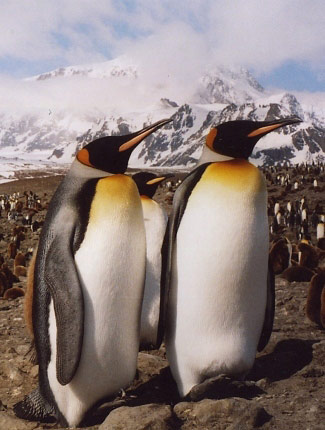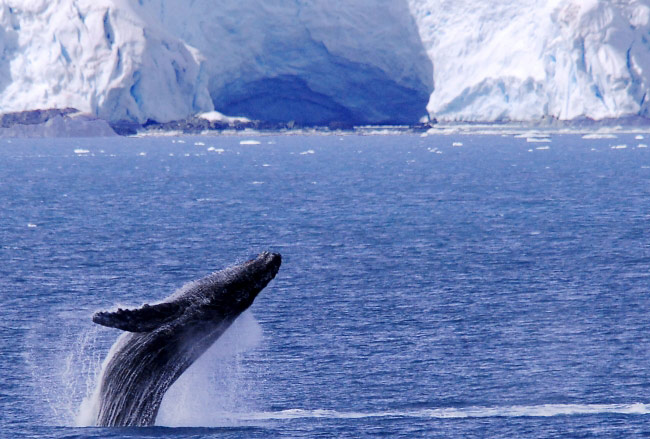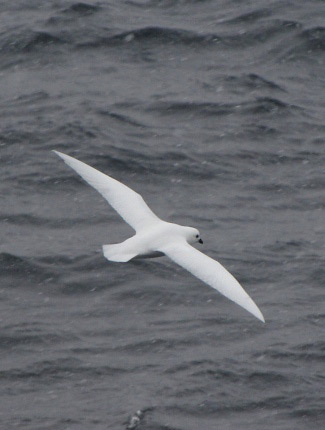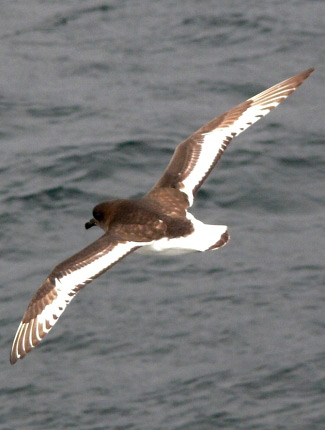

King Penguins at one of the several massive colonies on the island of South Georgia by Nigel Wheatley.
FALKLAND ISLANDS/ISLAS MALVINAS
- Some of the greatest concentrations of marine life in the world
- Including numerous whales such as Fin and Humpback, dolphins such as Commerson's, Southern Elephant Seals, sealions, fur seals and seals such as Leopard Seal
- And millions of seabirds, including King Penguin rookeries with hundreds of
thousands of birds, other penguin rookeries
of Adelie, Chinstrap, Gentoo, Macaroni and Rockhopper Penguins, albatrosses such as Wandering, Royal and Light-mantled, and numerous other seabirds such as Antarctic and Snow Petrels - All in possibly the greatest scenery on Earth, through the Southern Ocean to the island of glaciers and snow-capped peaks known as South Georgia, past icebergs to the ice and snow of Antarctica
- This 19 day cruise is extremely expensive; excluding return flights to the embarkation and disembarkation point(s), usually Ushuaia (on Tierra del Fuego) but also sometimes Puerto Madryn, in Southern Argentina, a twin-berth cabin with porthole and private facilities cost nearly GB£12,000/US$16,000 in 2020! It is possible however to take much cheaper 10-11 day cruises just to the Antarctic Peninsula, and to visit South Georgia on the half as cheap Atlantic Odyssey but that cruise involves a minimum of a month on board while the ships reposition from the Antarctic region during the northern winter to the Arctic region for the northern summer. It is South Georgia which is the best place for wildlife in this region and most of those who have paid for the experience of seeing it and stepping foot on it will no doubt say it is worth the money. Over 2000 km from South America across the Southern Ocean the island appears, like the Alps in the sea. This 160 km by up to 40 km range of snowy mountains and glaciers rising to nearly 3000 metres/10,000 feet may look bleak but the wildlife statistics present a different picture; three million fur seals, a few hundred thousand Southern Elephant Seals and an estimated 60 million breeding seabirds of 27 species, including 400,000 pairs of King Penguins, two million pairs of Macaroni Penguins, 4000 pairs of Wandering Albatrosses, 5000 pairs of Light-mantled Albatrosses, 3000 pairs of Snow Petrels, two million pairs of White-chinned Petrels and 22 million pairs of Antarctic Prions! Together they represent what may be the greatest concentration of life on Earth; something to behold in what is arguably the most picturesque place on the planet. Cruise ships stop at two or three bays where the big beaches, reached by Zodiacs, are covered with penguins and seals and once the feisty fur seals have been carefully negotiated it is possible to walk alone amongst the much more mild-mannered masses of blubber known as elephant seals and the masses of fearless King Penguins, including a colony estimated to contain 50,000 to 100,000 on a massive beach which is still known as Salisbury Plain. The most impressive bay however is arguably St Andrews where another 100,000 or so King Penguins complete a magnificent mountainous arena. The noise (and the smell!) is tremendous but this may soon be forgotten by visitors who sit still in one place and wait for the boldest penguins to wander over and stand beak-to-beak, as it were, with their admirers. From South Georgia ships sail to Antarctica, a pristine wonderland of pack ice, deep blue seas with beautiful icebergs of every conceivable shape and size, and whales and penguins, all lit by the most beautiful clear and crisp light. It really has to be seen to be believed and yet Antarctica almost seems like a bonus after South Georgia!
- For more details on the Falkland Islands see that destination.
- The odd lost Emperor Penguin is occasionally seen on this cruise but to see the rookeries of this bird it will be necessary to spend an awful lot more money on special Emperor Penguin cruises to places such as Snow Hill Island in the Weddell Sea.
Best Birds and other wildlife in Antarctica, South Georgia and the Falkland Islands
Birds
Most of the landbirds listed can be seen in Tierra del
Fuego NP near Ushuaia in Southern Argentina where cruises usually start and finish, or on
the Falklands. King, Macaroni, (Southern) Rockhopper, Adelie, Chinstrap, Gentoo and
Magellanic Penguins, Wandering, both Royal, Light-mantled, Black-browed and Grey-headed
Albatrosses, Antarctic and Snow Petrels, Magellanic Woodpecker, island endemics Falkland
Steamerduck, Blackish Cinclodes, Cobb's Wren and South Georgia Pipit, as well as Kelp,
Ruddy-headed and Upland Geese, Great and Silvery Grebes, Northern and Southern Giant-petrels,
Southern Fulmar, Blue, Pintado and White-chinned Petrels, Antarctic, Fairy and Slender-billed
Prions, Black-bellied, Grey-backed and Wilson's Storm-petrels, Common, Magellanic and South
Georgia Diving-petrels, Antarctic (Imperial), Rock and South Georgia (Imperial) Shags,
Black-faced Ibis, Black-chested Buzzard-eagle, Striated and White-throated (Ushuaia Rubbish Tip)
Caracaras, Snowy Sheathbill, Two-banded Plover, Rufous-chested Dotterel, Blackish and Magellanic
Oystercatchers, South American Snipe, Dolphin Gull, Antarctic Tern, Brown (Antarctic), Chilean
and South Polar Skuas, Thorn-tailed Rayadito, White-throated Treerunner, Dark-faced
Ground-tyrant, Austral Negrito, Patagonian Sierra-finch, White-bridled (Black-throated) Finch
and Long-tailed Meadowlark. Also a chance of Andean Condor, Spectacled Duck, Atlantic, Grey,
Kerguelen, Soft-plumaged and White-headed Petrels, White-bellied Seedsnipe and Yellow-bridled
Finch (both Garibaldi Pass and Martial Glacier near Ushuaia), and an outside chance of Emperor
Penguin.
Mammals
Humpback, Killer, Fin and Sei Whales, Commerson's,
Hourglass and Peale's Dolphins, Southern Elephant Seal, Leopard Seal, Southern Sealion,
Antarctic and South American Fur Seals, and Crabeater and Weddell Seals. Also a chance
of Blue, Southern Right (mostly Oct-Nov), Southern Bottlenose, Cuvier's Beaked, Gray's
Beaked and Antarctic Minke Whales. (Reindeer have been introduced to South Georgia).

Humpback Whale in Antarctica by Marie-France Grenouillet.
Other Natural Wonders of Antarctica, South Georgia and the Falkland Islands
Southern Ocean The roughest ocean on Earth is a stirring sight in such conditions, a scene completed by the seabirds which make light of high seas and strong winds.
South Georgia A high, snowy mountain range in the middle of the Southern Ocean, 170 km (110 miles) long, and between 2 and 40 km (1.2 and 25 miles) wide. Above the numerous glaciers the sharp peaks rise to 2934 m (9626 ft).
Antarctica Virtually the whole of the Antarctic continent is covered with ice, on average 3000 m (9800 ft) deep in the east, and much of the coastline is fringed with ice shelves about 200 m (650 ft) thick, pack ice and icebergs of every imaginable size and shape, so it is, more or less, completely picturesque, but some places are particularly picturesque and these include the 11 km (7 mile) long Lemaire Channel, an icy strait as narrow as 1600 m (5250 ft) in places, with walls up to 900 m (3000 ft) high. It is situated between the Antarctic Peninsula and Booth Island, which, ice conditions permitting, the cruises dealt with in this account, usually sail up and down, at almost the furthest south the ships can go.
Best Sites for Birds and other wildlife in Antarctica, South Georgia and the Falkland Islands
- Beagle Channel Magellanic Penguin, Black-browed Albatross and Magellanic Diving-petrel.
- Beagle Channel to the Falklands Wandering, both Royal, Black-browed and Grey-headed Albatrosses, Slender-billed Prion, and Common and Magellanic Diving-petrels
- The Falkland Islands Commerson's and Peale's Dolphins, Southern Sealion, South American Fur Seal, King, (Southern) Rockhopper, Gentoo and Magellanic Penguin rookeries, nesting Black-browed Albatrosses, Ruddy-headed Goose, Falkland Steamerduck, Imperial and Rock Shags, Striated Caracara, Two-banded Plover, Rufous-chested Dotterel, Blackish and Magellanic Oystercatchers, South American Snipe, Dolphin Gull, Cobb's Wren and White-bridled Finch.
- The Falkland Islands to South Georgia Wandering, both Royal, Light-mantled, Black-browed and Grey-headed Albatrosses, Blue Petrel, and Antarctic and Slender-billed Prions. Also a chance of whales and other petrels.
- South Georgia Southern Elephant Seal, Antarctic Fur Seal, King and Macaroni Penguin rookeries, nesting Wandering, Light-mantled and Grey-headed Albatrosses, Blue, Snow and White-chinned Petrels, Antarctic and Fairy Prions, Common and South Georgia Diving-petrels, Yellow-billed (South Georgia) Pintail, South Georgia Shag, Snowy Sheathbill, Antarctic Tern and South Georgia Pipit. Also a chance of whales.
- Scotia and Weddell Seas Light-mantled Albatross, and Blue and Snow Petrels. Also a chance of Antarctic Petrel and an outside chance of Emperor Penguin.
- Elephant Island Adelie, Chinstrap, Gentoo and Macaroni Penguins, and Southern Elephant Seal. Also a chance of Leopard Seal.
- Deception Island Chinstrap Penguin rookery.
- Livingstone Island Chinstrap and Gentoo Penguin rookeries.
- Paulet Island Adelie Penguin rookery, Snow Petrel, Antarctic Shag and Snowy Sheathbill. Also a chance of Killer Whale.
- Antarctic Peninsula Adelie and Gentoo Penguins, Snow Petrel, Antarctic Shag, Snowy Sheathbill, Antarctic Tern and South Polar Skua. Also a chance of Killer Whale and Leopard Seal.
- Drake Passage Wandering, both Royal, Light-mantled, Black-browed and Grey-headed Albatrosses, Blue Petrel, and Antarctic and Slender-billed Prions. Also a chance of whales and other petrels.

Snow Petrel by John Foster.

Antarctic Petrel in the Scotia Sea by Paul Macklam.
Best Times for Birds and other wildlife in Antarctica, South Georgia and the Falkland Islands
Cruises run from November to March. On South Georgia bird and animal activity is usually at a peak in October-November when bull elephant seals fight for control of harems and there are new and weaned pups on the beaches, young Wandering Albatrosses are stretching their wings in readiness for their first flights, and the wild 'pee-ow' calls of Light-mantled Albatrosses can be heard. Chinstrap, Gentoo and Macaroni Penguins also arrive at this time. By mid-November most bull fur seals are back; there are so many of them now (probably over four million) that they cover virtually every beach, making visits to some penguin colonies quite tricky due to their willingness to bite anything that intrudes on their territories. Female fur seals usually have pups in early December. Leopard Seals are mainly winter visitors to South Georgia and the vast majority move south during the southern spring so the best chances of seeing them between November and March come when the ships reach the Antarctic mainland.
South Georgia is not as cold as one might expect being so far south and close to Antarctica, and the average temperature at sea level between November and March is 7.5°C. However, when the wind picks up and blizzards blow, which happens frequently, it can feel much colder. Antarctica too is only really cold in such conditions, but it is often sunny and calm from November to March and, if suitably dressed, conditions can be surprisingly pleasant.
Recommended Bird Books etc. for Antarctica, South Georgia and the Falkland Islands
A Complete Guide to Antarctic Wildlife by H Shirihai. Helm, 2007 (Second Edition).
Birds and Mammals of the Falkland Islands by R and A Woods. WildGuides, 2006.
Field Guide to the Birds of Chile including the Antarctic Peninsula, the Falkland Islands and South Georgia by A Jaramillo. Helm, 2003.
Seabirds: The New Identification Guide by P Harrison, M Perrow and H Larsson. Lynx Edicions, due April 2021.
Oceanic Birds of the World: A Photo Guide by S Howell and K Zufelt. PUP, 2019.
Apps etc.
Antarctica Wildlife Guide.
Birding and Wildlife Trip Reports for Antarctica, South Georgia and the Falkland Islands
Many trip reports, some for Antarctica, South Georgia and the Falklands, are posted on the websites listed here. On some of these websites some reports are independent and some are posted by tour companies who organize tours to Antarctica, South Georgia and the Falklands. These tour companies and others also post their own reports on their websites, which are listed under 'Some Organized Tours to Antarctica, South Georgia and the Falklands' below.
- The best website for trip reports is CloudBirders
- but these are also worth a look
- Birdtours
- Fatbirder
- Jon Hornbuckle
- Mammal Watching
Specialist bird and wildlife guides for Antarctica, South Georgia and the Falkland Islands
The costs of organized tours partly reflect the quality of the tour leaders. Some leaders are certainly better than others and many companies claim their leaders are the best but even the best rely at least to some extent on the exceptional skills of the local guides they employ. If you are travelling independently, employing such local guides will greatly increase your chances of seeing the wildlife you wish to see.
Ship-based accommodation in Antarctica, South Georgia and the Falkland Islands
Some Organized Tours for birds and other wildlife to Antarctica, South Georgia and the Falkland Islands
There are many tour companies who organize tours to see mammals, birds, other wildlife and other natural wonders. The cost of these tours vary considerably according to such variables as the airlines used, the number of days the tours last, the number of sites visited, the number of people in the group (an important consideration if you wish to see such wildlife as rainforest mammals and birds), the number of tour leaders, the standard of accommodation and transport, and the percentage profit the company hopes to make. Generally, where the number of days tours last and the number of sites visited are similar, the cheapest tours are those that use the cheapest airlines, accommodation and local transport, that have the largest groups with the least number of leaders, and that make the least amount of profit. The most expensive tours tend to be those which are exceptionally long, use the most expensive accommodation (ridiculously lavish in some cases, even for single nights) and which make the most profit. Some tour costs partly reflect the quality of the tour leaders. Some leaders are certainly better than others and many companies claim their leaders are the best but even the best rely at least to some extent on the exceptional skills of the local guides they employ.
While tour companies organize tours with set itineraries many also organize custom tours for individuals and private groups who instead of taking a tour with a set itinerary want to follow their own itinerary to suit their own personal tastes, whether it be mammals, birds, other wildlife, other natural wonders or even man-made attractions, or a mixture of them all. Many organized tours with set itineraries are also fast-paced and target as many species as possible, whether they are mammals, birds or other wildlife or everything, which usually leaves little time to enjoy the best sites and individual species, but on a custom tour those taking part can specify the pace and the sites and species they wish to concentrate on. Custom tours also suit people who like to travel with people they already know, rather than with a group of strangers, and people with partners with different interests. Individuals and small groups will almost certainly have to pay more than the price of an organized tour with a set itinerary but a large group of friends may be able to travel for less than the price quoted for a set tour.
The most expensive cruises to Antarctica, South Georgia and the Falklands tend to be those on the largest and most lavish vessels where every cabin has private facilities, but it is the smaller vessels, with much smaller passenger numbers and mostly shared facilities, which enable greater and easier access to certain areas, and sometimes longer times ashore.
Tour companies who run or organize cruises to Antarctica, South Georgia and the Falklands include the following.
- Antarctica Bound
- Heritage Expeditions
- Island Holidays
- Naturetrek
- Oceanwide Expeditions
- Quark Expeditions
- Zegrahm and Eco Expeditions
